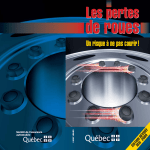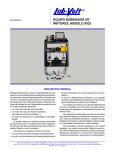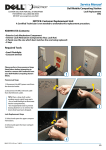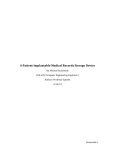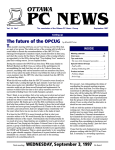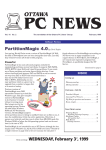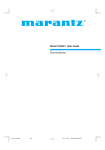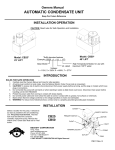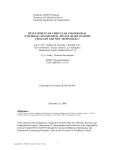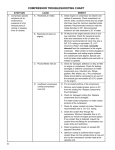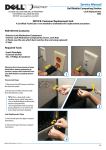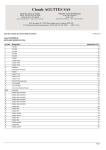Download Wheel Loss - A Risk No One Can Run!
Transcript
Wheel Loss C-3257-A R DE EVI CE SE MB D E ER DIT 19 ION 98 A risk no one can run! 1 Wheel Loss A risk no one can run! Research: Gilbert Lacroix Education science specialist Brochure aussi disponible en français. Acknowledgments Acknowledgments 2 The author is grateful for the collaboration of the following persons in the preparation of this wheel installation manual: ■ Mr. François Vaillancourt Alcoa Inter America inc. Representative for wheel sales, eastern Canada ■ Mr. Michel Drapeau, eng. Mr. Yves Boulanger, eng. Société de transport de la Rive-Sud de Montréal ■ Mr. Denis Cayer Facility advisor Association sectorielle transport entreposage ■ Mr. Pierre Lachapelle Training specialist Goodyear Canada inc. ■ Mr. Pierre Coulombe, foreman Mr. Michel Meunier, career consellor Mr. Michel Savignac, career consellor Centre de formation en transport de Charlesbourg ■ Mr. Henry Dawson Education Science Specialiste © Société de l’assurance automobile du Québec Direction des communications Legal deposit: Bibliothèque nationale du Québec – 4th quarter 1998 ISBN -2-550-30778 Foreword 3 This is not a text of law. For any question of a legal nature, please refer to the Highway Safety Code and attendant regulations. The information contained in this manual does not bind the SAAQ. Please note that the masculine form is used in some instances in this publication to include the female gender, with the sole intent of readability. Reproduction in whole or in part is allowed as long as the source is indicated. Please address your comments and suggestions concerning this manual in care of: Service de la sécurité et de l’ingénierie des véhicules Direction des politiques et des programmes de sécurité routière Société de l’assurance automobile du Québec P.O. Box 19600 333 boulevard Jean-Lesage, C-4-21 Québec (Québec) G1K 8J6 Foreward This manual, prepared by the road safety policy and programs division of the Société de l’assurance automobile du Québec, is intended to raise the awareness of heavy vehicle owners, wheel installers, drivers and maintenance staff on the importance of proper wheel installation and securing for safe travel. Contents Contents 4 1 1 Introduction 5 2 Responsibility 5 3 General Principles 6 4 The safe way to change heavy vehicle wheels (all types) Preparation Verification Mounting 8 8 9 9 4.1 4.2 4.3 5 5.1 5.2 Disc wheel with stud-located ball seat mounting Verification Torquing 10 10 11 6 6.1 6.2 Hub-piloted wheels Verification Torquing 14 14 15 7 7.1 7.2 7.3 7.4 Spoke wheels Verification Torquing Rim alignment check (spoke wheel) Correction of rim deviation 17 17 18 20 21 8 Tightening on the road 21 9 Wheel Bearings 22 Bibliography 23 Wheel Loss: A risk no one can run! Introduction Having wheels coming off a heavy vehicle is generally due to poor assembly, badly adjusted bearings or improper lubrication, or the result of inadequate maintenance and inspection. This manual summarizes safe practices for the installation and proper maintenance of spoke, hub and bud wheels. It gives specific advice on securing wheels, safety rules and tightening procedures to keep the wheel in place, according to the type of mounting system used for each. 2 Responsibility Taking preventive action is the only way to avoid wheels flying off. The vehicle owner, wheel installer, driver and person in charge of vehicle maintenance all have a role to play: The owner must make sure that the person who installs wheels or maintains wheel bearings on his vehicle has the know-how and ability to do that type of work. The installer, by reason of his skills in the field, must strictly observe installation standards and keep abreast of developments, so that the vehicle will be safe not only for the driver but for other road users as well. The driver is responsible for doing a safety check on the vehicle before setting out and during a trip, as required by regulation, before going back on the roadway after a rest or a stop at a restaurant, for instance. The driver is the person closest to the vehicle and must take responsibility for detecting anything out of the ordinary as far as the wheels or bearings are concerned, and see to it that needed repairs are done before taking to the road. The person in charge of maintenance must ensure that the carrier’s preventive maintenance program contains a section on the installation, inspection, maintenance and repair of wheels and bearings. A risk no one can run! 1 5 1-2 General Principles 6 Being responsible means you: General Principles ■ ■ ■ ■ 3 ■ ■ ■ Use a torque wrench, preferably, to tighten nuts to the recommended degree OR use an impact wrench equipped with a torque stick, the length of which corresponds to the wheel manufacturer’s recommended torque. Make sure when using an impact wrench not fitted with a torque stick to tighten nuts that it is well adjusted so torque values will be within recommended limits. Nut tightening must be checked and finished off with a torque wrench. Too much torque can be as dangerous as too little. Calibrate torque wrenches at least once yearly. Some brands of torque wrench have not been cabibrated by the manufacturer prior to purchase; these must be calibrated before use. Be attentive to the fact that when a reconditioned disc wheel is used, the layers of protective paint can amount to .012 in (.304 mm) thick, and could flake off under heat, resulting in loosening of the wheel. ◆ All traces of paint must be removed prior to tightening. Wheels must be reconditioned according to the manufacturer’s specifications. Retorque nuts on wheels after the first 80 to 160 km (50 to 100 miles) of service following installation. Keep wheels clean so as to more easily spot cracks, oil leaks, loose nuts or any other damage. Be attentive to the slightest oil leak, which points to a damaged hub ring seal or that a wheel bearing is about to slip out of the cup. Do not hesitate to remove a suspect wheel to examine the bearings. If lubricant is leaking, this situation must be corrected at once. Check wheels after an unusual manoeuvre such as sudden braking, to ensure no nut, stud or wheel has been damaged. Wheels can be loosened in a sharp turn involving contact with the edge of a sidewalk. An immediate inspection of those wheels is called for. General Principles 7 ■ 3 8 The safe way to change heavy vehicle wheels (All types) Wheel changing ✱: ✖: 4 These points apply to changing a wheel on the road. Applies to spoke wheels. 4.1 Preparation The driver must: ✱1. Bring his vehicle to a stop away from traffic on a solid, flat surface (preferably rest stop, garage) capable of supporting the weight of the load. 2. Apply the parking brake. 3. Make sure that the transmission is in first gear. ✱4. Put on the hazard lights. ✱5. Use warning lamps, flares or reflective accessoires specified in the Regulation respecting mechanical inspection and safety standards for road vehicles, as follows: ◆ on a road with two-way traffic, flares, lamps or emergency reflectors must be placed on the traffic side of the roadway, two at 3 m and 30 m to the rear of the vehicle and a third, at 30 m ahead of the disabled vehicle; ◆ on a divided highway, emergency reflectors must be placed on the roadway, 3, 30 and 60 m to the rear of the vehicle, facing oncoming traffic. 6. Place chocks under the wheels. 7. Install the jack in the recommended location. 8. Loosen nuts up to 1/2 a turn. 9. Jack the vehicle up so that the tire on the wheel to be replaced no longer touches the road. ✖10. Loosen nuts without removing them (risk of clamps flying off). ✖11. Use a hammer to dislodge the clamps. 12. 13. Remove the nuts: ✖ the clamps. Remove the outside wheel: ✖ and the spacer band (if necessary) ◆ the inner wheel (if necessary). 9 ■ ■ ■ For disc stud-located wheels, see section 5.1. For disc hub-piloted wheels, see section 6.1. For spoke wheels, see section 7.1. 4.3 Mounting The driver must: 1. Place the inner wheel back in the same spot as prior to removal if possible. 2. Make sure the valve stem is in the right location. ✖3. Replace the spacer between the wheels (dual assembly). 4. Replace the outer wheel and centre the valve (dual assembly). 5. Tighten the nuts slightly to about 50 ft-lbs (6,91 kgm). 6. Ensure that the wheel chocks are in place and the transmission is in first gear. ✖7. Tighten nuts according to the procedure described in section 7.2. ✖8. Release the parking brake. 9. Tighten wheels according to the procedure described in sections 5.2 and 6.2. ✖10. Check the wheel alignment according to the procedure in section 7.3. ✖11. Apply the parking brake. 12. Lower the wheel to the ground and check torque. 13. Remove the jack, the chocks and reflectors. 14. Check the torque again after travelling between 80 and 160 km (50 and 100 miles). Wheel changing 4.2 Verification 4 Ball seat cap nuts 10 Disc wheel with stud-located ball seat mounting; Ball seat cap nuts Wheel Cap nut Hub 5.1 Verification 5 N.B. Follow the wheel manufacturer’s instructions if different from below. You must: ■ Make sure the contact surfaces between the wheel and the drum are clean before mounting a wheel. ■ Check for cracks on the wheel or worn stud holes. ■ Check both sides of the disc area to see that there is no crack or warp. ■ Examine the entire wheel to see that there is no crack or gouge and no air leaking. ■ See that the threads on studs and nuts are clean and free of defects. ■ Be watchful for rust or dirt around a nut, which usually indicates it has been loose. Remember: Installing a stud-located wheel on a pilotmounted hub or vice versa can prove dangerous. 5.2 Torquing Diameter 3/4” Standard Type OR 7/8” 1 1/8” Threads Recommended Dry Torque 16 450 to 500 ft-lbs (62,21 to 69,13 kgm) Important: (aluminium wheels only) If a thread lubricant is used, reduce the torque to 350 to 400 ft-lbs (48,39 kgm to 55,30 kgm). Remember: The threads are right-handed on the right side of the vehicle and left-handed on the left side of the vehicle. The stud standout should be stamped L for LEFT or R for RIGHT. N.B.: This type of mounting requires an inner cap nut to centre and hold the inner wheel on a dual assembly and a ball seated nut to secure the outer wheel (Illustrations 1 and 2). You must: 1. Tighten the inner cap nut (Illustration 1) to a 50 ft-lbs (6,91 kgm) torque using the proper sequence (Illustration 3). 2. Tighten the nuts gradually to the recommended torque. 3. Tighten the outer nut (Illustration 2) to a 50 ft-lbs (6,91 kgm) torque using the proper sequence (Illustration 3). 4. Tighten the nuts gradually to the recommended torque. Illustration 1 Inner cap nut Illustration 2 Ball seat mount cap nut 11 Ball seat cap nuts Ball Seat Cap Nuts 5 1 Ball seat cap nuts 12 3 6 5 4 2 10 1 8 3 5 6 4 7 2 9 Illustration 3 Torque sequence, 6 and 10 stud wheels Apply no lubricant to the ball seat or threads. Lubricant changes the torque value and can overstress the stud, resulting in stripped threads. Nuts that are not tightened to the correct torque lead to premature stud wear, damaged ball seats and, most seriously, wheels coming off. Studs 5 Illustration 4 Studs and nuts Hub Drum Inner wheel Disc Outer wheel 13 Ball seat cap nuts Important: ■ On a dual stud-located wheel assembly, the outer wheel nuts must be loosened slightly and the inner wheel tightened to the recommended torque. ■ Then tighten the outer wheel following the torque sequence shown (Illustration 3). N.B.: When changing a stud on a 10-stud assembly (Illustration 4) is called for, adjacent studs should be replaced. In cases where the assembly has fewer than 10 studs, all of them should be replaced at once since the remainder have been subjected to greater stress and resulting metal fatigue could lead to breakage. Nuts 5 Hub-piloted wheels 14 Hub-piloted wheels Wheel 6 Nut Hub 6.1 Verification N.B.: Follow the wheel manufacturer’s instructions if different from below. You must: ■ Make sure the contact surfaces between the wheel and the drum are clean before mounting a wheel. ■ Check for cracks on the wheel or worn stud holes. ■ Check both sides of the disc area to see that there is no crack or warp. ■ Examine the entire wheel to see that there is no crack or nick and no air leaking. ■ See that the threads on studs and nuts are clean and free of defects. ■ Be watchful for rust or dirt around a nut, which usually indicates it has been loose. Remember: Installing a stud-located wheel on a pilotmounted hub or vice versa can prove dangerous. 6.2 Torquing 1 1/2” 33 mm Diameter Threads M22 1,5 15 Recommended Dry Torque 450 to 500 ft-lbs (62,21 to 69,13 kgm) Important: (aluminium wheels only) If a thread lubricant is used, reduce the torque to 350 to 400 ft-lbs (48,39 kgm to 55,30 kgm). 5 1 10 1 8 2 7 6 3 8 4 3 5 6 4 7 2 9 Hub-piloted wheels Wrench Size Illustration 5 Torque sequence, 8 and 10 stud wheels You must: 1. Use a torque wrench to tighten in the proper sequence (Illustration 5). 2. Tighten the nuts gradually to 50 ft-lbs (6,91 kgm). 3. Tighten the nuts gradually to the recommended torque. Note: All threads are right-handed. 6 Hub-piloted wheels 16 Flange Lubricate here Nut Illustration 6 Two-piece flange nut 6 4. Before reinstalling two-piece flange nuts, lubricate with a few drops of oil between the cap nut and the washer as shown in illustration 6. N.B.: When changing a stud on a 10-stud assembly (Illustration 4) is called for, adjacent studs should be replaced. In cases where the assembly has fewer than 10 studs, all of them should be replaced at once since the remainder have been subjected to greater stress and resulting metal fatigue could lead to breakage. Spoke wheels Spoke wheels 17 7.1 Verification N.B.: Follow the wheel manufacturer’s instructions if different from below. ■ You must: 1. Examine the rim mounting surfaces to make sure that there is no: ◆ dirt or foreign body to prevent good contact; ◆ defect or wear pattern (rim clamp slippage: Illustration 7); ◆ burr or foreign body (file smooth if necessary). 2. Check for cracked or broken spokes. 3. Replace the spacer band if it is in any way damaged. 4. See that threads are clean and free of defects. 5. Make sure that the rim clamps are in good condition. 6. Check that the valve locators are in the proper position and in good shape (Illustration 7). 7 Valve locators Spoke wheels 18 7 Slippage Illustration 7 Valve locators and slippage 7.2 Torquing Diameter Threads 5/8” 11 3/4” 10 Recommended Dry Torque 160 to 200 ft-lbs (22,12 to 27,65 kgm) 200 to 260 ft-lbs (27,65 to 35,94 kgm) Use a torque wrench to tighten rim clamps evenly in the sequence shown (Illustration 8). 1 1 3 6 5 4 1 6 5 2 3 Illustration 8 Torque sequence 4 3 4 5 2 2 Rims Flange Nut Spacer band Rim clamp Flange Wheel Illustration 9 Rim clamps and spacers Important: Do not tighten rim nuts excessively. Overtorquing can deform the rim spacer and damage the back flange (Illustration 9), and may lead to loss of a wheel. Spoke wheels 19 Illustration 10a Heel-less Rim Clamp 7 Rim Clamp Heel-less Wheel Gap Check position of rim clamps. 1. Heel-less rim clamps (Illustration 10a) should not contact the spoke. 2. Hell type clamps (Illustration 10b) should not bottom before 80% of final torque is reached, and may have up to 1/4” gap between the heel and the spoke, when fully torqued. If proper fit is not achieved, check spacer or rim clamp compatibility. 20 Spoke wheels Illustration 10b Hell Type Rim Clamp Rim Clamp Heel Wheel 7.3 Rim aligment check (spoke wheel) Clamp 7 Rim Chalk Wooden block Illustration 11 Checking rim aligment Proceed as follows: ■ Place a block of wood at 1/2” (12 mm) from the wheel; ■ rotate the wheel slowly, so you can see any variation; ■ correct any variation over 1/16” (1,6 mm) on the front wheel and 1/8” ( 3 mm) on the rear wheels. 21 You must: ■ Rotate the wheel slowly, bringing the chalk to the point where it makes a mark on the tire; this is maximum deviation (Illustration 11). ■ Slightly loosen the nut on the side with the greatest deviation. ■ Tighten the nuts opposite to this nut, one-quarter turn at a time, without overtorquing. ■ Check for deviation again. If there has been no change, look for deformed, crushed or broken part, or other defect. ■ Repeat the operation if necessary. Note: Deviation that is difficult to correct could point to a damaged component, in which case the entire assembly mut be checked again. Tightening on the road 7.4 Correction of rim deviation 8 Tightening on the road Tightening wheels without the use of a torque wrench is considered a temporary solution, which should be repeated every 80 to 160 km (50 to 100 miles), until the wheels can be properly tightened with a torque wrench (see “General Principles”, p. 6). If you have someone do the torquing on your vehicle, ask the person to write down the torque and the date the wrench was last calibrated. Wheel Bearings 1 Wheel Bearings 22 9 According to the results of an investigation ordered in September 1995 by the government of Maryland, USA the lack of proper lubrication for wheel bearings was among the main causes of wheel loss accidents. What occurs is that the bearings overheat due to a lack of lubricant. Without proper lubrication, tiny pieces of metal wear off the bearings and fall into the lubricating fluid, and serve as grinding compound for the bearing mecahnism. Once the mechanism is weakened, the lack of support for the hub/wheel/drum assembly results in the long term in wheel separation. There can be no doubt: Drivers and maintenance personel must pay more attention to the inspection and maintenance of wheel assemblies. ■ At what intervals must bearings be replaced when grease is used? ■ At what intervals should the level of lubricant be checked if oil is used? ■ At what intervals must the wheels be raised and rotated to check for bearing noise (cracked bearings) or excessive play (poorly adjusted)? ■ Has the driver been shown how to take hub temperature when inspecting tires on the vehicle in the course of the daily safety check? If not, delaying could spell disaster. Happy trails! 1. See “Wheel Loss Due to Faulty Bearings” also available free of charge from the Société de l’assurance automobile du Québec. Bibliography 23 Webb Wheel Products Inc., Installation, Service and Safety Instructions IM-494 Supersedes IM-989 REV.1 Mack, Manuel d’entretien des camions routiers, Chapter 7 TMC, The Maintenance Council. Recommended Maintenance Practices Manual 1994-1995 Kenworth, Maintenance Manual, Chapter 2, Wheels, Rims and Tires Centre de formation en transport de Charlesbourg, Québec. Méthode sécuritaire pour changer une roue sur un véhicule lourd (all types of wheels) adaptation. Bibliography Alcoa, Alcoa Aluminum Truck Wheel Service Manual And Operating Instructions, January 1994. C-3257-A

























